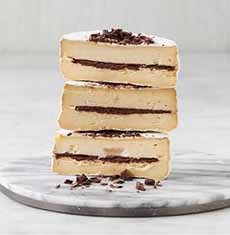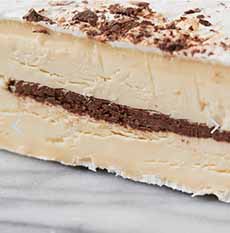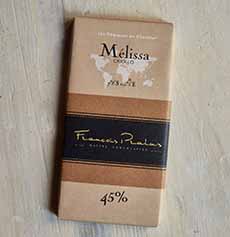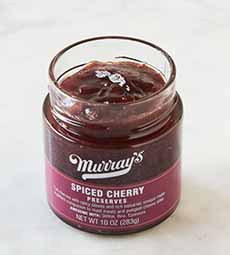|

[1] Triple Crème de Cocoa is a limited-edition triple creme cheese from Murray’s (all photos © Murray’s Cheese) .

[2] The wheels of cheese are filled with fine milk chocolate, chopped.

[3] A close-up of the finely-chopped chocolate.

[4] Pralus’ Melissa bar is a 45% cacao milk chocolate, which is a high percentage of cacao for a milk chocolate (a Hershey bar is 30% cacao).

[5] Murray’s recommends spiced cherry preserves as a cheese condiment.

[6] Overkill but fun: A triple crème hot fudge sundae.
|
|
We had this exciting wedge of cheese (photos #1, #2, and #3) two days ago as a Valentine’s Day treat. It’s our Top Pick Of The Week, and it’s a treat any day, from a special occasion to a gloomy day when you need some food that delivers a big smile. The solution: Murray’s Cave Aged Limited Triple Crème de Cocoa. What is it? A triple-creme cheese filled with chocolate! And it’s our Top Pick Of The Week.
The ingredients:
Cheese: The rich, buttery triple-crème cheese is one of our favorites, St. Stephen from Four Fat Fowl’sof New York State.
Chocolate: The filling is a crushed chocolate bar from one of the world’s great chocolatiers, François Pralus, Maitre Chocolatier of France. The bar used is Melissa, a 45% cacao bar. The high cacao content means intense milk chocolate flavor with less sugary sweetness.
The experience: heavenly! Cheese and chocolate are a popular combination among some connoisseurs. Yes, send for a wedge of this cheese, but also:
Check out our article on pairing cheese and chocolate.
For yummy fun, a gourmet grilled cheese sandwich with chocolate “soup.”
How about a tequila and chocolate pairing?
We love the Chocolate Capri Cheese Log from Westfield Farm (a previous Top Pick Of The Week).
A chocolate mousse with blue cheese recipe.
A chocolate topping on a cherry cheesecake recipe.
A milk chocolate cheesecake.
Cream cheese brownies recipe.
> Get your Murray’s Cave Aged Limited Triple Crème de Cocoa here.
WHAT IS TRIPLE CRÈME CHEESE?
There’s more about them below, but first came double-creme cheese.
The first double-crème cheese was made in Normandy, France in 1850 by a cheesemaker whose name has been lost to history. He was a short man of Swiss extraction, and called his cheese Petit-Suisse (possibly his nickname).
Anyone who has ever enjoyed a Brie or other double-crème cheese can appreciate that it was a big success. Other cheesemakers tried their hands and a category was born.
By law, a French double-crème cheese has between 60% and 75% butterfat. Note that this is the percentage of fat in the dry matter of the cheese. Most double- and triple-crèmes have about 50% moisture, so a Brie that has 60% butterfat in the dry matter is actually 31% total fat.
As a point of reference, butter itself contains between 80% total fat (the legal minimum in the U.S) to 86% total fat.
Examples Of Double-Crème Cheeses
Well-known double-crème cheeses from France include:
Boursault
Brie (a minority of Bries are triple-crèmes)
Fromage D’Affinois
Petit-Suisse
Domestic beauties include:
Bodacious from Bohemian Creamery in California
Cremont from Vermont Creamery
Old Europe Cheeses Double Cream Brie with Peppercorns and Double Creme Brie With Herbs, from Michigan
La Bonne Vie Double Creme Brie from Wisconsin
Ask your cheesemonger for recommendations for other cheeses he/she may have on hand.
TRIPLE CRÈME CHEESES
Like the first double-crème, the first triple-crème cheese was also made in Normandy (France’s dairy heartland), 75 years after Petit-Suisse was introduced. Called Le Magnum, it was made by the Dubuc family and was the ancestor of Brillat-Savarin. By law, French triple-crème cheeses must have a butterfat content of 75% or more.
Take a bite of:
Brillat-Savarin French Triple Cream Cheese from France, one of the richest there is. Beer drinkers, try with a stout for a coffee-with-cream experience. See more in the footnote*.
Delice de Bourgogne Cheese from France.
Mt. Tam Triple Cream from Cowgirl Creamery in California.
Triple Cream by Coach Farm (made with goat’s milk), from New York State.
Fromager d’Affinois Excellence, a triple-crème Brie from France with three times the butterfat of a traditional Brie.
Hofmeister-Champignon Cambozola from Germany, sometimes called a “blue Brie.”
St. Stephen from Four Fat Fowl in New York State.
Trillium, from Tulip Tree Creamery in Indiana.
Triple Cream Brie from Old World Cheeses in Indiana.
|
HOW TO SERVE A DOUBLE-CRÈME OR TRIPLE CRÈME CHEESE
You can go from basic (fresh fruit) to gourmet (black or white truffles).
Fresh Fruits
Grapes, mango, raspberries, or strawberries are the best matches.
Truffles
Cut the cheese in half horizontally; spread the bottom cut side with truffle butter or shaved truffles, and replace the top half of the cheese (let it sit for 30 minutes to develop flavor).
Optional additions to the filling: toasted walnuts (toast then chop) or, with shaved truffles, a thin layer of mascarpone and/or a drizzle of honey.
Bread or Crackers
Choose among baguette slices, water biscuits, wheatmeal biscuits (slightly sweetened whole wheat crackers), raisin-walnut crisps, or just about any artisan cracker.
To Drink
Beer: Dark beer including porter and stout.
White wine: Viognier.
Red Wine: Beaujolais, Bordeaux, Burgundy.
Sparkling wine: Champagne and other sparkling wine or cider.
> THE DIFFERENT TYPES OF CHEESE
> THE HISTORY OF CHEESE
> THE DIFFERENT TYPES OF CHOCOLATE
________________
*Brillat-Savarin was created by Henri Androuet in 1890. He named it for the famous 18th-century French gastronome, Jean-Anthelme Brillat-Savarin, the author of the Physiologie du Gout (Physiology of Taste), published in 1826. Brillat-Savarin’s most famous quote: “Tell me what you eat and I will tell you what you are.”
CHECK OUT WHAT’S HAPPENING ON OUR HOME PAGE, THENIBBLE.COM.
|








